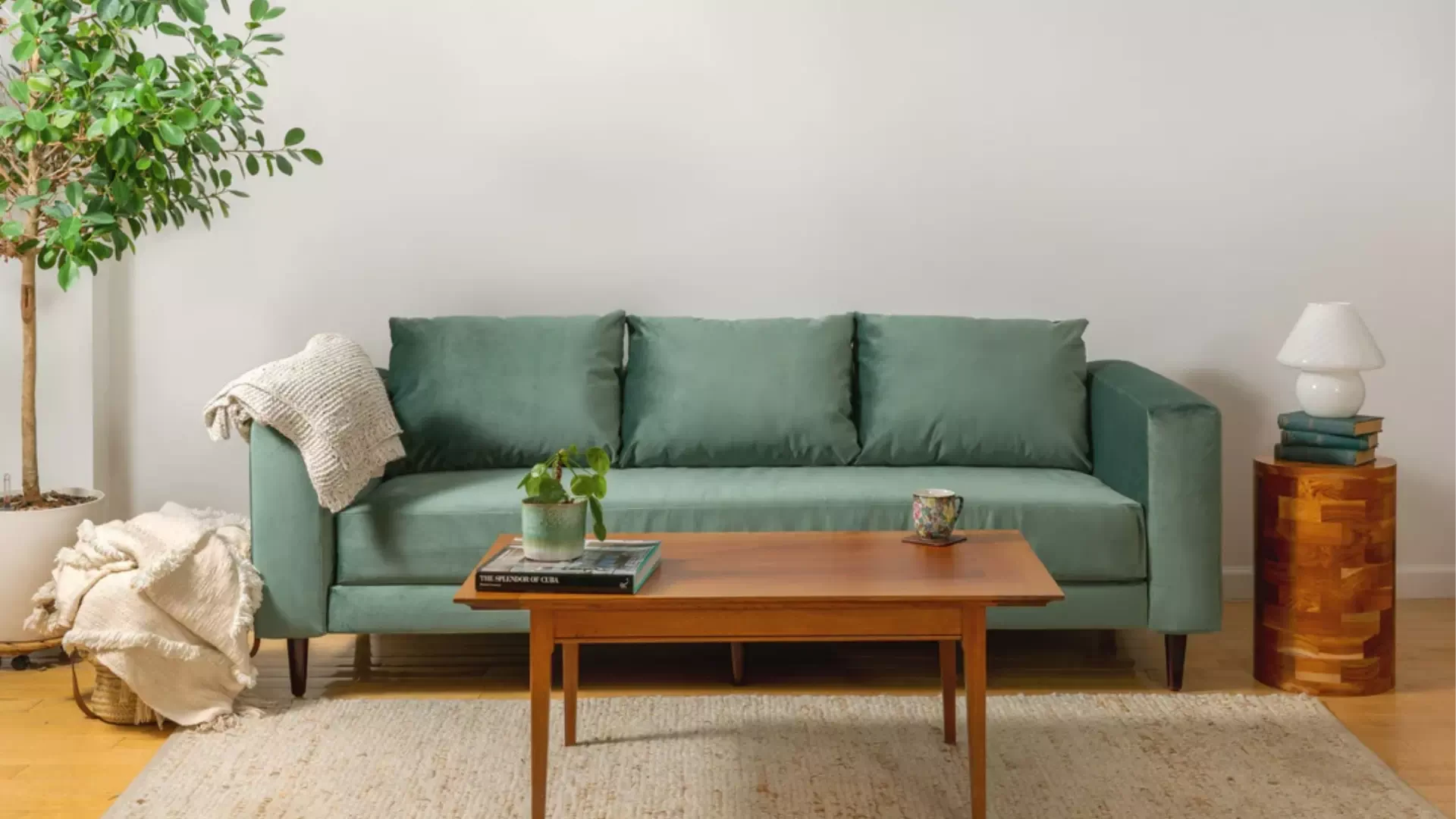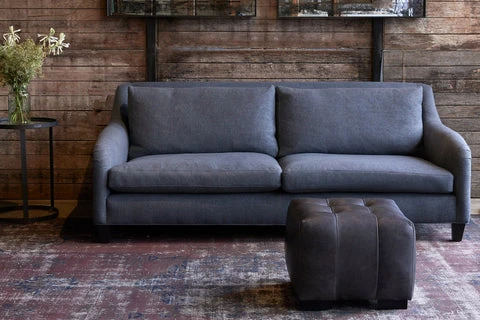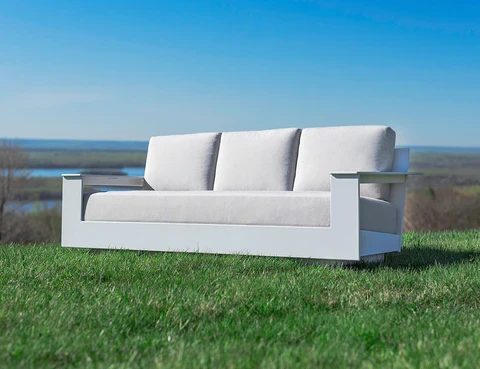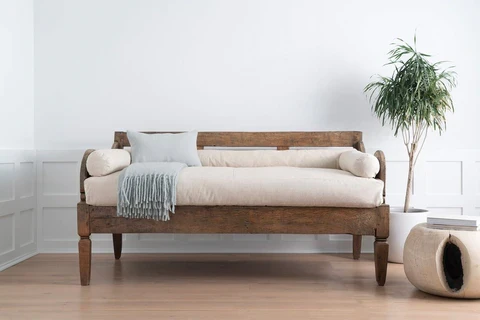
Keep Your Sofa Out of the Landfill
18-Nov-2021
Furniture and Circularity: A Primer
In today’s world of abundant options and free delivery, it’s easy to save money on a cheap sofa without thinking about its short lifespan. As soon as the fabric rips, you’re scouring the internet for a replacement and the barely four-year-old sofa is on its way via the curb to the trash pile.
There, it joins the 12.1 million tons of furniture and furnishing waste created by the United States every year. This familiar cycle is the current linear economy in action: a system of take-make-use-waste that dominates consumption patterns at home and across the globe.
In this new series of articles, we’ll present an alternative - principles of the circular economy. It’s a simple idea -- stop taking limited resources from, and start restoring, the earth. We’ll explore basic principles of ‘circularity’ and how even furniture can be climate-positive and restorative. Here, in Part 01, we’ll explore why the circular economy matters, its origins and main principles.
Why the Circular Economy Matters
While the term “circular economy” didn’t gain popularity until the 1990s, the concept appeared in ecological research as far back as the 1940s. Its importance has grown rapidly over the past two decades as it becomes clearer that humans are in a battle with finite resources and on a path to climate destruction.
Our current economic system created a mountain of waste and poses serious threats to the health of our planet and its inhabitants. In 2018, the U.S. Environmental Protection Agency (EPA) noted that the average person in the U.S. discarded 4.9 pounds of municipal solid waste per day, totaling 292.4 million tons per year, a whopping 8% increase from the previous year. Only 32.1% of that waste was recycled or composted.
The furniture industry alone fills colossal landfills. New York City alone produce 346,750 tons of furniture waste per year. Meanwhile, manufacturing one sofa produces on average 90 kilograms of carbon dioxide or similar emissions, which is equal to emitting 10.1 gallons of gas.
Amid these grim statistics there is hope. The Ellen MacArthur Foundation (EMF), a leader in today’s circular economy movement, reports that if today we were to fully transition to the circular economy, we could achieve a 48% reduction in carbon dioxide emissions by 2030 and $700 billion in annual material cost savings in the global consumer goods industry.
What Is the Circular Economy?
The circular economy - according to EMF, is based on three basic principles: (1) designing out waste and pollution, (2) keeping products and materials in use, and (3) regenerating natural systems.
These principles undergird a constant cycle of reuse that touches all levels of a product's life cycle, including design, manufacturing, use, and disposal. Imagine starting with a blank slate and re-envisioning every product. A circular product is made from sustainable materials and is built for longevity. When it is no longer usable in its current state, it can be easily broken down or reformulated into a new product, with no parts going to landfill or polluting the environment. Every product becomes a shape-shifting environmental superhero!
Luckily, current trends are in the circular economy’s favor: today, more than ever, customers want to buy from companies that are transparent and act sustainably. Simultaneously, advances in technology have paved the way for innovation. Take a look at this video to see how consumers and companies can “exercise [their] circular brains” --
Let’s explore the three principles of the circular economy, following the life-path of a sofa.
Principle #1: Designing Out Waste and Pollution / Designing a Circular Sofa
“Design is never done” is a north star for the Ellen MacArthur Foundation. The first principle 'designing out waste and pollution' puts design at the heart of the circular economy. Thoughtful design is a critical tool to reduce or, ideally, eliminate waste and pollution. Indeed, 80% of a product’s life cycle costs and environmental footprint are decided in the design phase. This leads to products that are adaptable, durable, and recyclable, while using environmentally-friendly materials and production processes.


A sofa by Loll Design sofa, made of recycled plastic and durable Sunbrella fabric. Choosing recycled materials reduces the demand for raw resources such as virgin plastic, and helps to divert plastic waste from landfills, extending the lifecycle of this material and reducing pollution.
Principle #2: Keeping Products & Materials in Use / Sofa Becomes Superhero
The principle of ‘keeping products & materials in use’ tackles two interrelated subjects: finished products and the materials that go into them. We’re aiming for sofas that don’t live just one life in one person’s home, office or apartment. Similarly, the materials and parts that make up the sofa must also have future purposes. This is called a “closed loop” cycle, in which everything stays in a productive loop, ultimately vastly reducing the need to extract new resources or fill landfills.

ZZ Driggs rents couches and other furniture, encouraging multiple users over time. Rather than a single owner using and then often discarding the item, ZZ Driggs furniture is returned, refurbished if necessary, and rented out again. This business model keeps furniture in circulation longer, a key aspect of the second principle of the circular economy.
Principle #3: Regenerating Natural Systems / Superhero Sofa 2.0
The third principle, regenerating natural systems, looks to go way beyond minimizing harm - it is about furniture designed to actually benefiting the planet. This means returning used natural resources to biodegrade into the ground and nourish the Earth. Your favorite sofa will be fully circular when it is made 100% from compostable materials; then, at the end of its life, it can be disassembled and turned into nutrients for soil where trees are grown. Regenerating natural systems also applies to people and communities. This translates into valuing and nourishing the health and well-being of everyone engaged in, or living near, production of the sofa.
What’s Next?
While the emergence of the circular economy in the furniture industry is off to a promising start, we still have a lot to learn and a lot of work to do! Such a transition, of course, is riddled with huge challenges. Overcoming these will require innovation, systems and behavioral change, strong leadership, enlightened public policy, financial incentives, global collaboration, and inclusivity.
Fortunately, the growth of the modern circular economy has accelerated over the past twenty years. Once marginalized concepts - such as waste-to-resource innovation, upcycling and modular design - are now taking center stage. Circular economy principles provide a powerful framework for ever-evolving ideas and creativity. A sofa featuring - for example - repairable and replaceable modular parts, non-toxic finishes and no-glue, and repurposed materials such as textiles and wood can become the new norm. A sofa could represent the pinnacle of circular design - rather than one of the most environmentally degrading furniture pieces.
Next up on this series, we'll bring real-life case studies from the furniture industry - as a means of diving deep into each circular principle. Explore our next article " RETHINKING DESIGN: How furniture companies are embracing circular-economy principles" to find out more.
By Mona Chun and Danya Rubenstein-Markiewicz, mebl | Transforming Furniture
READ other articles in the series - Furniture and Circularity: A Primer.
References:
Top photo credit: Sabai. Photograph. 2020. https://gbdmagazine.com/sabai/
Ekins, Paul, Teresa Domenech, Paul Drummond, Raimund Bleischwitz, Nick Hughes, and Lorenzo Lotti. The Circular Economy: What, Why, How and Where. OECD. 2019.
https://www.oecd.org/cfe/regionaldevelopment/Ekins-2019-Circular-Economy-What-Why-How-Where.pdf
Ellen MacArthur Foundation and IDEO. “The Circular Design Guide.” 2018. https://www.circulardesignguide.com/
Ellen MacArthur Foundation and IDEO. “Finding a circular opportunity - Circular Design Guide.” Video. 2016. https://www.youtube.com/watch?v=mUe10dvm1ZE
McGinty, David. “5 Opportunities of a Circular Economy.” World Resources Institute. 2021. https://www.wri.org/insights/5-opportunities-circular-economy
Stanislaus, Mathy. “Barriers to a Circular Economy: 5 Reasons the World Wastes So Much Stuff (and Why It’s Not Just the Consumer’s Fault).” World Resources Institute. 2018. https://www.wri.org/insights/barriers-circular-economy-5-reasons-world-wastes-so-much-stuff-and-why-its-not-just
Whelan, Tensie and Carly Fink. “The Comprehensive Business Case for Sustainability.” Harvard Business Review. 2016. https://hbr.org/2016/10/the-comprehensive-business-case-for-sustainability
Benchmarking Carbon Footprints of Furniture Products. Furniture Industry Research Association. 2011. http://www.healthyworkstations.com/resources/Environment/FIRA.CarbonFootprint.pdf
"Climate Change Series Part 2 -- Rainforest Destruction is a Major Contributor to Global CO2 Emissions.” Rainforest Alliance. 2017. https://www.rainforesttrust.org/climate-change-series-part-2-rainforest-destruction-major-contributor-global-co2-emissions/
Ellen MacArthur Foundation. https://ellenmacarthurfoundation.org/
“Intact Forests” Wildlife Conservation Society. 2030. https://www.wcs.org/our-work/solutions/climate-change/intact-forests
“National Overview: Facts and Figures on Materials, Wastes and Recycling.” Environmental Protection Agency. 2018. https://www.epa.gov/facts-and-figures-about-materials-waste-and-recycling/national-overview-facts-and-figures-materials
“Nisswa Sofa.” Loll Designs. Photograph. 2021. https://lolldesigns.com/products/nisswa-sofa?variant=32931022405772
“Overview of Greenhouse Gases.” Environmental Protection Agency. 2019. https://www.epa.gov/ghgemissions/overview-greenhouse-gases#carbon-dioxide
“Willard Sofa.” Cisco Homes. Photograph. 2021. https://ciscohome.net/collections/all-sofas/products/willard-sofa
“Winged-Arm Hand Carved Teak Daybed.” ZZ Driggs. Photograph. 2021. https://zzdriggs.com/products/winged-arm-hand-carved-teak-daybed-rent?variant=29215105482867
